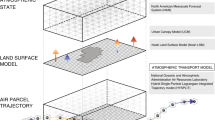Abstract
A numerical investigation is conducted of the nocturnal heat island over Columbus, Ohio, a relatively flat mid-latitude city. Specifically, a cross-sectional steady-state numerical model to simulate the (thermal) structure of the nocturnal urban boundary layer is developed from a one-dimensional, time-dependent model due to Estoque. The model is applied to Columbus for special periods in September 1968 and March 1969 during which comparable experimental data were collected. The numerical simulations agree well with the observed data with respect to the detailed spatial form of the surface-based thermal boundary layer across the city. The use of the model for other metropolitan areas, for ascertaining the relative effect of city size and building geometry on the development of the thermal boundary layer, and for determining the effect of alternate land-use strategies on the thermal stratification are also discussed.
Similar content being viewed by others
References
Angell, J. K., Pack, D. H., Dickson, C. R., and Hoecker, W. H.: 1971, ‘Urban Influence on Night-time Airflow Estimated from Tetroon Flights’,J. Appl. Meteorol. 10, 194–204.
Balchin, W. G. V. and Pye, N.: 1947, ‘A Micro-Climatological Investigation of Bath and the Surrounding District’,Quart. J. Roy. Meteorol. Soc. 73, 297–304.
Beaty, J. R. and Kircher, D. S.: 1970, ‘Columbus, Ohio, Metropolitan Area Heat Emission Inventory’, Air Pollution Control Office, EPA, Durham, N.C.
Bornstein, R. D.: 1968, ‘Observations of the Urban Heat Island Effect in New York City’,J. Appl. Meteorol. 7, 575–582.
Chandler, T. J.: 1967,The Climate of London, Hutchinson, 292 pp.
Clarke, J. F.: 1969, ‘Nocturnal Boundary Layer Over Cincinnati, Ohio’,Monthly Weather Rev. 97, 582–589.
Clarke, J. F. and McElroy, J. L.: 1970, ‘Experimental Studies of the Nocturnal Urban Boundary Layer’, WMO Tech. Note No. 108, WMO Note No. 254. TP 141, 108–112.
DeMarrais, G. A.: 1961, ‘Vertical Temperature Differences Observed over an Urban Area’,Bull. Amer. Meteorol. Soc. 8, 548–554.
Duckworth, F. S. and Sandberg, J. S.: 1954, ‘The Effect of Cities upon Horizontal and Vertical Temperature Gradients’,Bull. Amer. Meteorol. Soc. 35, 198–207.
Estoque, M. A.: 1963, ‘A Numerical Model of the Atmospheric Boundary Layer’,J. Geophys. Res. 68, 1103–1113.
Estoque, M. A. and Bhumralkar, C. M.: 1968, ‘Theoretical Studies of the Atmospheric Boundary Layer’, Final Rep., Contract DA-AMC-28-043-67-G2, Inst. of Atmos. Sci., Univ. of Miami, 46 pp.
Geiger, R.: 1965,The Climate near the Ground, Harvard Univ. Press, Cambridge, Mass., 611 pp.
Georgii, H. W., Busch, W. and Weber, E.: 1968, ‘Über die räumliche und zeitliche Verteilung von Schwefeldioxid und Sulfatoersolen in der unteren Troposphäre’, Scientific Rep., Inst. of Meteorol. and Geophys., Univ. of Frankfort/Main, 55 pp.
Leahey, D. M.: 1969, ‘An Urban Heat Island Model’, Final Rep., Geophys. Sci. Lab., TR-69-11, School of Engr. and Sci., New York Univ., 70 pp.
Lumley, J. L. and Panofsky, H. A.: 1964,The Structure of Atmospheric Turbulence, John Wiley and Sons, New York, 239 pp.
McElroy, J. L.: 1971, ‘An Experimental and Numerical Investigation of the Nocturnal Heat-Island over Columbus, Ohio’, Ph.D. Dissertation, the Penna. State Univ., 132 pp.
Myrup, L. O.: 1969, ‘A Numerical Model of the Urban Heat Island’,J. Appl. Meteorol. 8, 908–918.
Oke, T. R. and East, C.: 1971, ‘The Urban Boundary Layer in Montreal’,Boundary-Layer Meteorol. 1, 411–437.
Olfe, D. B. and Lee, R. L.: 1971, ‘Linearized Calculations of Urban Heat Island Convection Effects’,J. Atmospheric Sci. 28, 1374–1388.
Ozolins, G. and Smith, R.: 1966, ‘A Rapid Survey Technique for Estimating Community Air Pollutant Emissions’, PHS Publication No. 999-AP-29.
Summers, P. W.: 1965, ‘An Urban Heat Island Model - Its Role in Air Pollution Problems with Application to Montreal’, Paper presented at the First Canadian Conf. on Micrometeorology, Toronto, 29 pp.
Sundborg, A.: 1950, ‘Local Climatological Studies of the Temperature Conditions in an Urban Area’,Tellus 2, 222–232.
U. S. Weather Bureau: 1968,Climatological Data, Ohio, September.
U. S. Weather Bureau: 1969,Climatological Data, Ohio, March.
Vukovich, F. M.: 1971, ‘Theoretical Analysis of the Effect of Mean Wind and Stability on a Heat Island Circulation Characteristic of an Urban Complex’,Monthly Weather Rev. 99, 916–929.
Author information
Authors and Affiliations
Additional information
Digest of portion of a dissertation submitted to the Pennsylvania State University in partial fulfillment of the requirements for the degree of Doctor of Philosophy.
On assignment from the National Oceanic and Atmospheric Administration (NOAA), U.S. Department of Commerce.
Rights and permissions
About this article
Cite this article
McElroy, J.L. A numerical study of the nocturnal heat island over a medium-sized mid-latitude city (Columbus, Ohio). Boundary-Layer Meteorol 3, 442–453 (1973). https://doi.org/10.1007/BF01034987
Received:
Issue Date:
DOI: https://doi.org/10.1007/BF01034987




